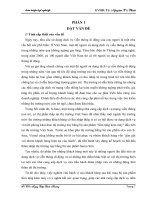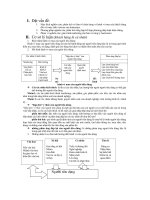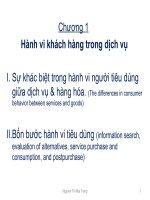Quan hệ tương quan giữa hành vi khách hàng gửi tiền và việc lựa chọn giao dịch ngân hàng trong khu vực các quận nội thành hà nội
Bạn đang xem bản rút gọn của tài liệu. Xem và tải ngay bản đầy đủ của tài liệu tại đây (1.73 MB, 182 trang )
..
SOUTHERN LUZON STATE UNIVERSITY, LUCBAN, QUEZON, PHILIPPINES
IN COLLABORATION WITH
THAI NGUYEN UNIVERSITY, SOCIALIST REPUBLIC OF VIETNAM
_______________________________________________________________________________
CORRELATION OF DEPOSITORS’ BEHAVIOR AND BANK
PATRONAGE IN THE INNER DISTRICTS OF HA NOI
DOCTOR
OF BUSINESS ADMINISTRATION
BY
TRINH THANH BINH – BECKAM
August, 2013
1
ACKNOWLEDGEMENT
I would like to express my heartfelt gratitude to leaders of Thai Nguyen
University in VietNam and Southern Luzon State University in the Philippines who
created best conditions for me to complete the course generally and fulfill the thesis
particularly.
My gratitude goes towards Professors directly gave me useful and memorable
lectures and guides in DBA namely Dr. Professor Cecilia N. Gascon, Dr. Professor
Walberto A. Macaraan, Dr.Professor Melchor Melo O. Placino, Dr.Professor Alice T.
Valerio, Dr. Professor Do Anh Tai, and Dr.Professor Tran Dai Nghia. They provided
me a rich and fertile environment to study and explore new ideas. They made my
DBA life is ever fluid, and, in the course of it all, a warm and inviting place to work.
My special thank to Dr. Professor Cecilia N. Gascon who provided me
valuable guides to complete the dissertation.
I am grateful to lecturers who managed the International Cooperation Program
between Vietnam and the Philippines namely Professor Tran Tuan Anh and Professor
Nguyen Thanh Hai. Without their cooperation, I could not have chance to join and
fulfill the course.
I would not have contemplated this road if not for my parents, my wife, my
children, and all of my dear friends who instilled within me a love of creative
pursuits, science and language, all of which finds a place in this the dissertation.
Trinh Thanh Binh
July, 2013
i
TABLE OF CONTENTS
ACKNOWLEDGEMENT
i
TABLE OF CONTENTS
ii
ABSTRACT
vii
LIST OF TABLES
viii
LIST OF FIGURES
xiv
LIST OF APPENDICES
xv
CHAPTER
I.
II.
INTRODUCTION
1
1.1. Background of the Study
1
1.2. Objectives of the Study
3
1.3. Statement of the Problem
3
1.4. Hypotheses of the Study
4
1.5. Significance of the Study
5
1.6. Scope and limitation of the Study
6
1.7. Definition of Terms
7
REVIEW OF LITERATURE AND STUDIES
10
ii
2.1. Economic Development
10
2.1.1 Viet Nam Economy
10
2.1.2. Ha Noi Economic Development
11
2.2. Regulation of Banking Industry
12
2.2.1. Background of Vietnam Banking Industry
12
2.2.2. Key Challenges Facing the Banking Industry
13
2.3. Background of Ha Noi Banking Industry
15
2.3.1. Banking Industry in Ha Noi
15
2.3.2. Practice in Deposit Mobilization in Ha Noi
15
2.4. Consumer Behavior
16
2.5. Review of Related Studies
20
2.6. Psychological Attributes of Depositors’ Behavior in Bank
22
Patronage
2.6.1. External Psycological Attributes
22
2.6.2. Internal Attributes
23
2.7. Factors Influencing Depositor Behavior in Deposit
24
2.7.1. Subjective Factors
24
iii
III.
IV.
2.7.2. Objective Factors
25
2.8. Conceptual Framework
27
METHODOLOGY
29
3.1. Research Design
29
3.2. Determination of Sample Size
29
3.3. Sampling Design and Techniques
30
3.4. Subject of the Study
31
3.5. Research Instrument
31
3.6. Data Collection Method
31
3.7. Data Processing Method
32
RESULTS AND DISCUSSION
34
4.1. Depositors’ Profile
34
4.2. Depositors’ Distribution by Districts
36
4.3. Attributes of Depositors’ Behavior in Bank Patronage in the
37
Inner Districts of Ha Noi
4.3.1. External Attributes Implication of Depositors’ Behavior
37
4.3.1.1. Depositors’ Selection by Specific Banks and Type of
37
Banks – Foreign Banks, State Owned Banks and Joint Stock Banks
4.3.1.2. Time Span Depositors Began Relationship with Banks
39
iv
4.3.1.3. Depositors’ Selection of the Deposit Kinds and Terms
42
4.3.2. Depositors’ Motivation in Bank Patronage
47
4.3.2.1. Depositors’ Motivation for Changing a Bank
47
4.3.2.2. Depositors’ Motivation for Selecting Banks They Deposit
54
with
4.3.2.3. Depositors’ Expectation on the Future Promotions
65
4.3.2.4. Depositors’ Future Investment Plan
68
4.3.2.5. Depositors’ Willingness to Make a Reference with Their
72
Friends
4.3.3. Depositors’ Perception and Bank Patronage
74
4.3.3.1. Depositors’ Attitudes in Acceptance of Interest Rate
74
4.3.3.2. Depositors’ Attitudes in Acceptance of Bank Service Quality
75
4.3.3.3. Depositors’ Attitudes for Existing Promotion Programs
77
4.3.3.4. Depositors’ Perception of Bank Safety
83
4.4. Factors Influencing Depositors’ Behavior in Bank Patronage in
85
the Inner District of Ha Noi
4.4.1. Depositors’ Selection of Factors and Factors’ Correlation
85
4.4.2. Critical Factors
89
v
V.
4.4.2.1. Prestigious Banks
89
4.4.2.2. Quick and Convenient Procedure
91
4.4.2.3. Competitive Interest Rates
91
4.4.2.4. Security and Safe
93
4.4.2.5. Convenient Location
94
SUMMARY, FIDINGS, CONCLUSIONS AND
95
RECOMMENDATIONS
5.1. Summary of Findings
95
5.2. Conclusions
102
5.3. Recommendations
105
BIBLIOGRAPHY
109
APPENDICES
114
SURVEY QUESTIONNAIRES
151
CURRICULUM VITAE
161
vi
ABSTRACT
This study was conducted to determine and analyze the correlation of
depositors’ behavior and bank patronage in the inner districts of Ha Noi. As the
knowledge of depositors’ behavior and bank patronage is not well understandable
and given the critical importance of understanding of depositors’ behavior, this study
intended to identify the factors influencing depositors’ behavior and define the
winning strategies for the banks in fund mobilization.
The methodology of the thesis was to review the various relevant literatures.
Method of system analysis, method of fieldwork, method of comparison, quantitative
research methods and forecasting method were also used in the study.
This research was conducted within the inner districts of Hanoi with 257
respondents, which were selected based on random probability. Findings showed that
depositors’ behavior was influenced by both internal demographic factors and
external factors. The result further revealed a high correlation between depositors’
behavior and factors such as “prestigious banks”, “security and safe”, “competitive
rates”, “quick and convenient procedure”. However, lower correlation was obtained in
depositors’ perception and attitudes.
The recommendations are developed from the insights and conclusions. First
is to address the brand issue of banks that built through depositors’ perception of
“bank safety”, “prestigious” and other key influencers. Second, banks should take
into account all factors in their winning marketing strategies. Third is to recommend
the contingency plan that banks should have to keep safe. And the
last is to
recommend the SBV need to liberalize interest rates on deposits.
vii
LIST OF TABLES
Table
CONTENT
Page
Table 1
Bank classification by ownership and key indicators as of 30
June 2013
13
Table 2
Depositors’ profile
35
Table 3
Distribution of depositors by gender and marital status
36
Table 4
The bank selection by bank ownership
38
Table 5
Distribution of depositors by banks
39
Table 6
The period of time that depositors maintain relationship with
40
Banks
Table 7
Relation between marital Status and time span with banks
41
Table 8
Relation between age range and time span with banks
41
Table 9
Relation between professional, employment and time span
42
with banks
Table 10
Kind of deposits
43
Table 11
Deposit maturity
44
Table 12
Relation between marital status and type of deposits
44
Table 13
Relation between age range and terms of deposits
45
Table 14
Relation between education background and terms of deposits
45
Table 15
Relation between professional, employment and types of
46
deposits
Table 16
Relation between professional, employment and terms of
47
deposits
Table 17
Reasons for depositors to change banks (having at least two
49
banks at the same time) by gender and marital status
viii
Table 18
Reasons for depositors to change banks (having at least two
49
banks at the same time) by age
Table 19
Reasons for depositors to change banks (having at least two
50
banks at the same time) by education background
Table 20
Reasons for depositors to change banks (having at least two
50
banks at the same time) by employment
Table 21
Reasons for depositors to change banks (having at least two
51
banks at the same time) by income
Table 22
Relation between education background and the factor “to seek
51
for stronger reputation”
Table 23
Relation between professional and employment with the factor
52
“to seek for the best/better service”
Table 24
Relation between professional and employment with the factor
53
“I was not happy with the service so I switch to another bank”
Table 25
Descriptive Statistics of the factors depositors select to answer
53
the question why
Table 26
Correlation of the factors depositors select to answer the
54
question why
Table 27
Reasons for depositors to select the first banks
57
Table 28
Relation between age range and the factor of “paper and
57
electronic statements”
Table 29
Relation between age range and the factor of “security and
58
safe”
Table 30
Relation between education background and the factor of
58
“security and safe”
ix
Table 31
Relation between education background and the factors of
59
“prestigious banks, clear explanation and procedure, banks
with branches locate at my convenient place, paper and
electronic statements”
Table 32
Relation between education background and the factor of
59
“competitive interest”
Table 33
Relation between education background and the factor of
60
“paper and electronic statements
Table 34
Relation between education background and the factor of “can
60
make deposit/withdrawal flexibly”
Table 35
Relation between professional and employment and the factor
61
of “competitive interest”
Table 36
Relation between professional and employment and the factor
62
of “prestigious banks”
Table 37
Relation between professional and employment and the factor
62
of “security and safe”
Table 38
Relation between income and the factor of “paper and
63
electronic statements”
Table 39
Relation between income and the factor of “recommendation
63
from friends/relatives”
Table 40
Relation between income and the factor of “banks with
64
branches locate at my convenient place”
Table 41
Descriptive statistics of factors for depositors’ selection of
64
the First Bank they deposited with
Table 42
Correlation of the factors for depositors’ selection of the
65
x
first bank they deposited with
Table 43
Type of promotion that depositors want to have?
66
Table 44
Type of promotion that depositors want to have first?
67
Table 45
Relation between income and lottery participation
67
Table 46
Descriptive statistics of the promotion kinds depositors want
68
to have
Table 47
Correlations of the promotion kinds depositors want to have
68
Table 48
Depositors’ future plan to invest their money
69
Table 49
Relation between marital status with depositors’ plan to
70
deposit foreign currency at banks
Table 50
Relation between age range with depositors’ plan to deposit
70
foreign currency at banks
Table 51
Relation between income with depositors’ plan to deposit
71
foreign currency at banks
Table 52
Relation between income with depositors’ plan to buy gold
71
and save at home
Table 53
Descriptive statistics of future investment factors
72
Table 54
Correlation of future investment factors
72
Table 55
Depositors’ willingness to introduce their banks with friends
73
Table 56
Relation between education background with depositors’
73
willingness to refer banks with their friends.
Table 57
Relation between education background with depositors’
74
willingness to refer banks with their friends.
Table 58
Depositors’ acceptance of interest rates banks offer
75
Table 59
Depositors’ evaluation of service quality of banks
76
xi
Table 60
Relation between marital status and the rating of service
76
Satisfaction
Table 61
Promotion received
78
Table 62
How depositors like received promotion
79
Table 63
Types of promotion depositors received
79
Table 64
Depositors’ selection of promotion ranking the first
79
Table 65
Relation between income and the response to the question:
80
“did you receive any promotion?”
Table 66
Relation between age range with the kinds of promotion
80
Received
Table 67
Relation between age range and the depositors’ ranking of
81
promotion kinds they like most
Table 68
Relation between professional, employment and the
82
depositors’ ranking of promotion kinds they like most
Table 69
Relation between income and the depositors’ ranking of
82
promotion kinds they like most
Table 70
descriptive statistics of promotion kinds depositors received
83
for making deposits at banks
Table 71
Correlation of promotion kinds depositors received for
83
making deposits at banks
Table 72
Depositors’ response to the question as keeping money at
84
banks always safe
Table 73
Relation between employment with depositors’ perception of
85
the bank safety
Table 74
factors that depositors would consider when selecting a bank
87
xii
for deposits
Table 75
The influencing factor that depositors rank as the first
88
Table 76
Descriptive statistics of the factors depositors would consider
88
Table 77
to select banks for deposits in the next time
Correlation of the factors depositors would consider to select
89
banks for deposits in the next time
Table 78
Relation between income with prestigious banks
90
Table 79
Relation between education with prestigious banks and
91
security and safety
Table 80
Relation between education with competitive interest rates
92
Table 81
Relation between employment with the factor of competitive
93
interest rates
xiii
LIST OF FIGURES
Figure
CONTENT
Page
Figure 1
Conceptual Model of Consumer behavior
9
Figure 2
Conscious Problem Solving and Learning Model of Consumer
10
Behavior
Figure 3
28
Conceptual Framework
xiv
LIST OF APPENDICES
Appendix
CONTENT
page
Appendix A.1
List of State Owned Banks (SOBs) as of 30 June 2013
114
Appendix A.2
List of Jointstock Commercial Banks (JSCBs) as of 30 June
115
2013
Appendix A.3
List of foreign banks branches as of 30 June 2013
117
Appendix A.4
List of Joint Venture Banks as of 30 June 2013
120
Appendix A.5
List of 100% owned Foreign Banks as of 30 June 2013
120
Appendix B.1
Distribution of depositors by age
121
Appendix B.2
Distribution of depositors by education background
121
Appendix B.3
Distribution of depositors by Professional and employment
122
Appendix B.4
Distribution of depositors by income
122
Appendix B.5
Distribution of depositors’ first bank selection by gender,
123
marital status and age
Appendix B.6
Distribution of depositors’ second bank selection by gender,
123
marital status and age
Appendix B.7
Distribution of depositors’ third bank selection by gender,
123
marital status and age
Appendix B.8
Distribution of depositors’ fourth bank selection by gender,
124
marital status and age
Appendix B.9
Reasons for depositors to select the second banks
124
Appendix B.10
Reasons for depositors to select the third banks
125
Appendix B.11
Reasons for depositors to select the fourth banks
125
Appendix B.12
Descriptive statistics of factors for depositors’ selection of
126
xv
the Second Bank they deposited with
Appendix B.13
Correlation of the factors for depositors’ selection of the
127
Second bank they deposited with
Appendix B.14
Descriptive statistics of factors for depositors’ selection of
128
the Third Bank they deposited with
Appendix B.15
Correlation of the factors for depositors’ selection of the
129
Third bank they deposited with
Appendix B.16
Descriptive statistics of factors for depositors’ selection of
130
the Fourth Bank they deposited with
Appendix B.17
Correlation of the factors for depositors’ selection of the
131
Fourth bank they deposited with
Appendix B.18
Type of promotion that depositors want to have second?
132
Appendix B.19
Type of promotion that depositors want to have third?
132
Appendix B.20
Type of promotion that depositors want to have fourth?
132
Appendix B.21
Type of promotion that depositors want to have fifth?
133
Appendix B.22
Depositors’ selection of promotion ranking the second
133
Appendix B.23
Depositors’ selection of promotion ranking the third
133
Appendix B.24
Depositors’ selection of promotion ranking the fourth
134
Appendix B.25
Depositors’ selection of promotion ranking the fifth
134
Appendix B.26
The influencing factor that depositors rank as the second
134
Appendix B.27
The influencing factor that depositors rank as the third
135
Appendix B.28
The influencing factor that depositors rank as the fourth
135
Appendix B.29
The influencing factor that depositors rank as the fifth
136
Appendix B.30
The influencing factor that depositors rank as the sixth
136
Appendix B.31
The influencing factor that depositors rank as the seventh
137
xvi
Appendix B.32
The influencing factor that depositors rank as the eighth
137
Appendix B.33
The influencing factor that depositors rank as the ninth
138
Appendix B.34
The influencing factor that depositors rank as the tenth
138
Appendix B.35
The influencing factor that depositors rank as the eleventh
139
Appendix B.36
Relation between age range with the factor suitable fees and
139
charges
Appendix B.37
Relation between marital status with the factor of can make
140
deposit/withdrawal flexibly
Appendix B.38
Relation between age range with the factor of can make
141
deposit/withdrawal flexibly
Appendix B.39
Relation between education with can make
142
deposits/withdrawal flexibly
Appendix B.40
Relation between employment with the factor of can make
143
deposits/withdrawal flexibly
Appendix B.41
Relation between marital status with the factor of clear
144
explanation and procedure
Appendix B.42
Relation between education with the factor of paper and
145
electronic statement
Appendix B.43
Relation between employment with the factor of competitive
146
interest rates
Appendix B.44
Relation between income with paper and electronic statements
147
Appendix B.45
Relation between age range with the factor of
148
recommendations from friends/relatives
Appendix B.46
Relation between employment with the factor of
149
xvii
recommendations from friends/relatives
Appendix B.47
Relation between income with recommendations from
150
friends/relatives
xviii
CHAPTER I
INTRODUCTION
Fund mobilization is essential to banks’ success. Recently, banks face with
strong competition in attracting and retending depositors. Many banks fail to mobilize
funds while others are able to understand better depositors and depositors’ behavior in
bank patronage and take advantadge of their knowledge to win the game. In the study,
the researcher would like to address the issue of depositors’ behavior and bank
patronage.
1.1
Background of the Study
Vietnam economy has been in the fast growth track for a decade. Vietnam
GDP growth is mainly come from government capital expenditure and private sector
investment. The fast infrastructure development and urbanization process require
huge source of funding.
One of the engine to lure the growth is the expansion of
credit by banking sectors.
The banking sector in Viet Nam consists of
5 state owned banks, 37
commercial joint stock banks, 53 foreign – related banks, 30 financial companies and
finance lease companies, 1 Central People Credit Fund and 1,057 local people credit
funds (Nguyen C.T., 2011). The number is quite big giving the Vietnam’s GDP per
capital is 1,300 USD by 2011 (Dantri, 2011). The competition is high in the sector,
especially in main economic and political areas like Ha Noi and Ho Chi Minh cities.
The interest income contributes a major part of banks income. Most banks have their
income heavily dependent on lending activities with interest income to total income
ratio of some banks reaching above 90% in 2010 (Quach, 2011). This causes many
1
banks concentrating on fund mobilization. One of key sources of fund would be the
depositors’ funding. The source of fund is viewed as a stable funding and counts for a
big part in banks’ balance sheet. Many strategies that banks persuad to lure their
deposit growth including branch network expansion, high interest rate offer, attractive
promotion campaigns.
Due to the fact that the banking sector plays a key part in the economic
activities and economic development, and social stability as well, the banking
activities in Vietnam have been highly regulated. There are still many different
experts’ opinions on if the banking sector needs to be moving more deregulation or
regulation. However, taking the reason to prevent banks’ failure, the State Bank of
Viet Nam put in place a very high level on banks supervision. Some regulations that
directly affect banks’ expansion of credit and fund mobilization include control of
capital adequacy, bank liquidity ratio, and the banks’ branch network expansion. Even
though, the State Bank of Viet Nam tries to communicate and act to prevent the
banks’ failure in the future. However, depositors are always facing with risk of losing
their fund in case of banks’ run or bankruptcy. For deposit insurance, the depositors
can receive is 30 million VND at maximum as per law.
To study the depositors’ behavior is always necessary for banks to serve better
their clients. In fact, a few information of depositors’ behavior have been made
available in public sources in Viet Nam. Information is normally in the form of
observation and experts’ opinion. In late 2013, there is a doctorate study on individual
customers’ depositing behavior at banks made by Le Thi Thu Hang, which is
available at the Viet Nam Instiute of Social Science. Le T.T.H (2012) scoped her
study at nationan-wide scale and focused on individuals who had or did not have a
deposit at banks. However, there has not been a similar study of the correlation
2
between depositors’ behavior and bank patronage in Ha Noi that the researcher could
identify in the public sources. In addition, depositors’ behavior would always reflect
through certain factors. Therefore, the study of the correlation of depositors’ behavior
and bank patronage should be a key success factor for banks to win in the deposit
competition race in Ha Noi and for those who want to get knowledge of the study.
1.2
Objectives of the Study
The main objective of the study is to determine and analyse the correlation of
depositors’ behavior and bank patronage in the inner districts of Ha Noi. Besides, the
search aims to achieve the following objectives:
1. To describe the background of the general economic environment and the
banking industry in Ha Noi
2. To determine and analyse comsumer behavior model and to determine
depositors’ behavior model
3. To characterise the profile of the depositors in Ha Noi
4. To identify the factors that influence the depositors’ behavior in selecting
banks in the inner districts of Ha Noi.
5. To determine the correlation of depositors’ behavior and bank patronage in
the inner districts of Ha Noi.
6. To identify the winning strategies for banks in fund mobilization.
1.3
Statement of the Problem
Funding mobilization is very ctitical to banks in Vietnam, especially in Ha Noi
as a large number of banks with too high credit growth (Quach, 2011) with the limited
source of owners capital need to maintain their growth and liquidity by seeking
3
deposits from public. In addition, banks face with stiff competition in deposit
mobilization and this makes banks more difficult in attracting and keeping depositors.
Ha Noi is a big city where all banks have presence and try to gain advantage over
competitors. Understanding depositors’ behavior in Ha Noi would help banks adapt
their funding strategies accordingly. However, there is a very limited knowledge of
depositors’ behavior available in the research or at bank strategists’ desk. Therefore, it
should be an opportunities for researchers to study the depositors’ behavior and make
it useful to all stakeholders.
To understand the depositors’ behavior in bank patronage. The following
questions will be addressed:
1. What is the background of banking industry in Ha Noi?
2. What are the profile of depositors in Ha Noi?
3. What are the implications of depositors’ behavior?
4. How are the depositors’ behavior and bank patronage correlated?
5. What
are the factors that influence the depositors’ behavior in selecting
banks?
6. How do depositors prioritize the factors?
7. What are the winning strategies for the banks in fund mobilization?
1.4
Hypotheses of the Study
The following hypotheses will be tested:
Hypothesis 1: Depositors’ behavior in bank patronage is positively correlated to the
level of interest rates that banks offer for taking deposits.
Hypothesis 2: Depositors’ behavior in bank patronage is positively correlated to the
availability of the bank.
4
Hypothesis 3: Depositors’ behavior in bank patronage is positively influenced by
referral from friends or relatives.
Hypothesis 4: Depositors’ behavior in bank patronage is positively correlated with the
promotion campaigns that banks offer to depositors.
Hypothesis 5: Depositors’ behavior in bank patronage is positively correlated with the
bank reputation in the market.
Hypothesis 6: Depositors’ behavior in bank patronage is positively correlated with the
service quality that depositors experience with banks.
Hypothesis 7: Depositors patronize the banks when their deposit is secured.
1.5
Significance of the Study
The study is important as it addresses to answer several key questions and it
benefits researchers and banks in setting up their strategy in fund mobilization.
The study is to identify the factors that influence depositors’ behavior in
selecting banks for placing their deposits.
For the banking industry’s regulator, it finds out the gap between the fact and
polices for fund mobilization, implication for strenthening the policy environment.
For the banks, they understand factors to influence the depositors’ behaviors;
through which banks would be able to address key issues that influence depositors in
bank patronage and able to reshape their policies and strategies to win the
competition.
For marketers, the understanding of depositor behavior and influencing factors
would help them to develop suitable and effective marketing campaigns.
For researchers and students, they would have a valuable information about
depositor behavior in Ha Noi and apply in the work and study.
5









